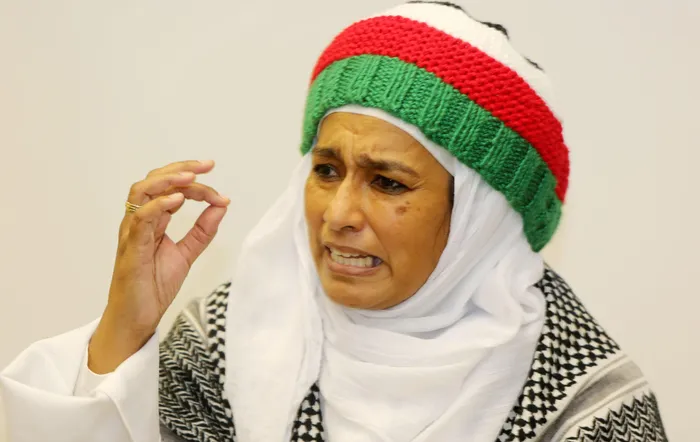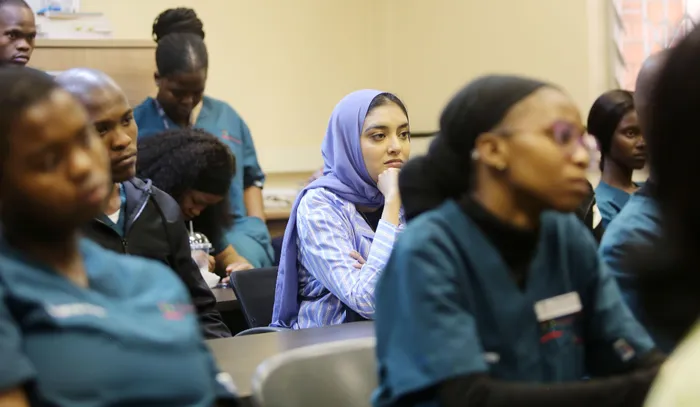South African activist details harrowing detention by Israeli forces during Gaza aid mission
Renews commitment to Palestinian cause amid injustice

Dr Fatima Hendricks at UKZN.
Image: Tumi Pakkies/Independent Newspapers
CAPE Town activist Dr Fatima Hendricks recounted her traumatic six-day detention in an Israeli prison after being captured in international waters while participating in a humanitarian flotilla to Gaza.
Despite facing humiliation and abuse, including mockery about her mastectomy, the breast cancer survivor remains resolute in her commitment to the Palestinian cause.
Last week Dr Hendricks, met with the University of KwaZulu Natal’s occupational therapy academics as well as the third-year students in Durban where she spoke on “Health justice lessons learnt from the Global Sumud Flotilla.”
In a sit down interview with the POST before her speaking engagement, Hendricks, who is an occupational therapist, author and breast cancer survivor, shared her harrowing experience of being captured by the Israeli Defense Force while in international waters, and then detained in a prison under inhumane conditions for six-days.

Dr Hendricks met with occupational therapy academics as well as the third-year students at UKZN. She spoke on “Health Justice - Lessons learnt from the Global Sumud Flotilla.”
Image: Tumi Pakkies/Independent Newspapers
The 50-year-old activist, was among a group of six South Africans, including high-profile activist Mandla Mandela, who were captured while participating in the Global Sumud Flotilla, which is aimed at breaking the blockade on aid being provided to Palestinians living in Gaza.
Hendricks said the mission was not only a humanitarian effort but a non-violent demonstration against oppression and injustice, echoing the struggles of apartheid South Africa, she experienced first-hand.
Reflecting on her childhood, Hendricks, who grew up in Reservoir Hills, said a very big part of her childhood was living through apartheid in South Africa.
She said she later became actively involved in student activism while studying at the then-University of Durban-Westville, and her commitment to social justice continued across various parts of the world including in the United States, Saudi Arabia, Syria, and Turkey, among others.
Hendricks said her time working with cancer patients along the Turkish-Syrian border further cemented her resolve to advocate for those suffering, such as the people of Palestine, under oppressive circumstances.
“The Palestinian cause has always been dear to my heart. I visited Palestine and witnessed its oppression which motivated me to act. I was motivated to be part of the flotilla by the fact that they were trying to break the siege, but it was also a non-violent effort.
“There were about 30 000 applications for the flotilla. I joined through the Global Movement to Gaza, which is one of the various partners that was putting the flotilla together. I had to undergo a vigorous vetting process before I was successful.
“On being accepted, I travelled to Tunisia where I underwent various training such as how to be on a boat, communication skills and first aid, among others. We were thereafter allocated a boat that we would sail on. I was on a boat called Amsterdam,” she said.
Hendricks said they came under attack several times and were tormented before their boat was intercepted in September.
“We were attacked twice while still in Tunisia, and then 14 times while on the waters in Greece. The Israeli forces dropped incendiary bombs and flashbangs on our boat, which would dull our senses and leave us feeling disoriented. Furthermore, before they attacked they played music by Abba. It was dark nights, and dark seas. We never knew which side they would attack from. We were civilians in international waters, what they were doing was a crime and went against international humanitarian laws,” she said.
Hendricks said a day before their boat was intercepted they were alerted to be on guard and spread the word.
“We got a notification that the Israeli forces were heavily armed and had a blockade set up which we were heading towards. We were told to activate our protocol in respect of an attack. The night before we got intercepted, they were circling us, and at one point came right next to us to try and push us off our tracks. We were then attacked with four water cannons. The boat was vibrating and it was as if the windows were about to crack. This went on for hours and we were ‘sitting ducks’.
“When the boat was intercepted in the early morning hours, we were told that we were in illegal waters, which was incorrect. Our boat was 40 nautical miles from Gaza when we were intercepted. We were told to walk to the deck, with our arms raised. But we never surrendered to the Zionist occupation forces. I put my hands out in front of me and said to them, ‘we are humanitarians, we are in international waters, stand down’,” she said.
Hendricks said they were taken to Ashdod, a city in Israel.
“During this time they wanted me to remove my hijab which I refused. I have been wearing my hijab since I was 11-years-old. They accused me of being a terrorist because I was wearing ‘big sandals’. I had been paralysed before due to having Guillain-Barré syndrome. I was on life support for 30 days, in ICU for 40 days, in hospital for four months, and rehab for 18 months. I had to learn how to walk, talk and breathe again.
“I was then diagnosed with breast cancer and had a bilateral mastectomy. They chose that particular moment - during my strip search- to mock my body. The female soldier told all of the male soldiers that I did not have breasts and what my body looked like, ”she said.
Hendricks said she also refused to sign any documentation.
“They offered me 72 or some hours to be released if I signed the documents, but I refused. I kept saying I am a humanitarian worker, I have been kidnapped in international waters. We kept demanding consular services and legal representation, but were denied. The very first time I saw a lawyer was at my court hearing.”
Hendricks said they were then taken to Ketziot, a high-security prison in the Negev desert.
“We were shoved around and put into a prison truck with no ventilation. When we arrived at the prison and they saw I was a South African, I was told ‘welcome to paradise’. During this time we were denied medical care and had to fight for it. It was only after we got legal representation that we received medical assistance.
“There were five of us that were pushed into a cell. Through a small hole, we could see the quad. They would bring food and leave it there, but we did not get it initially. We were locked up the entire day and night, even though we were supposed to have an hour of air in the quad. The only way we were taken out was when we had an appointment.
“I also won’t forget the day after we arrived, a large banner appeared in the quad, with the words ‘Gaza al-Jadida’, meaning a new Gaza. It depicted a bombed Gaza with a corridor and displaced people. There was also writing on our cell walls by prisoners who were once held captive - the last was from September. I also remember seeing the blood splatters on the wall, including the imprint of a hand. I placed my hand over it and prayed,” she said.
The mother of two said throughout her experience, her faith played a great role.
“Together with my faith, I drew inspiration from the Palestinian people who have been experiencing this occupation for eight decades and seeing them show resistance day after day. I feel what we experienced was really insignificant when compared to what the occupation has put people through in Palestine.”
Hendricks said after a concerted international outcry, she and her fellow South African activists were eventually released and repatriated to South Africa on October 7.
She added that she finds herself more resolute than ever in the mission to fight against injustice, with plans to continue shining a light on the Palestinian cause.